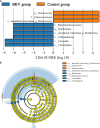Gut Microbiota Dysbiosis in BK Polyomavirus-Infected Renal Transplant Recipients: A Case-Control Study
- PMID: 35694540
- PMCID: PMC9186314
- DOI: 10.3389/fcimb.2022.860201
Gut Microbiota Dysbiosis in BK Polyomavirus-Infected Renal Transplant Recipients: A Case-Control Study
Abstract
Background: BK polyomavirus infection results in renal allograft dysfunction, and it is important to find methods of prediction and treatment. As a regulator of host immunity, changes in the gut microbiota are associated with a variety of infections. However, the correlation between microbiota dysbiosis and posttransplant BK polyomavirus infection was rarely studied. Thus, this study aimed to characterize the gut microbiota in BK polyomavirus-infected renal transplant recipients in order to explore the biomarkers that might be potential therapeutic targets and establish a prediction model for posttransplant BK polyomavirus infection based on the gut microbiota.
Methods: We compared the gut microbial communities of 25 BK polyomavirus-infected renal transplant recipients with 23 characteristic-matched controls, applying the 16S ribosomal RNA gene amplicon sequencing technique.
Results: At the phylum level, Firmicutes/Bacteroidetes ratio significantly increased in the BK polyomavirus group. Bacteroidetes was positively correlated with CD4/CD8 ratio. In the top 20 dominant genera, Romboutsia and Roseburia exhibited a significant difference between the two groups. No significant difference was observed in microbial alpha diversity. Beta diversity revealed a significant difference between the two groups. Nine distinguishing bacterial taxa were discovered between the two groups. We established a random forest model using genus taxa to predict BK polyomavirus infectious status, which achieved the best accuracy (80.71%) with an area under the curve of 0.82. Two genera were included in the best model, which were Romboutsia and Actinomyces.
Conclusions: BK polyomavirus-infected patients had gut microbiota dysbiosis in which the Firmicutes/Bacteroidetes ratio increased in the course of the viral infection. Nine distinguishing bacterial taxa might be potential biomarkers of BK polyomavirus infection. The random forest model achieved an accuracy of 80.71% in predicting the BKV infectious status, with Romboutsia and Actinomyces included.
Keywords: BK polyomavirus; gut microbiota; infection; microbial dysbiosis; renal transplantation.
Copyright © 2022 Zhang, Qin, Chang, Yang and Lin.
Conflict of interest statement
The authors declare that the research was conducted in the absence of any commercial or financial relationships that could be construed as a potential conflict of interest.
Figures





Similar articles
-
Urine Donor-Derived Cell-Free DNA Helps Discriminate BK Polyomavirus-Associated Nephropathy in Kidney Transplant Recipients With BK Polyomavirus Infection.Front Immunol. 2020 Aug 19;11:1763. doi: 10.3389/fimmu.2020.01763. eCollection 2020. Front Immunol. 2020. PMID: 32973745 Free PMC article.
-
Prospective study of posttransplant polyomavirus infection in renal transplant recipients.Exp Clin Transplant. 2011 Jun;9(3):175-80. Exp Clin Transplant. 2011. PMID: 21649565
-
Association of gut microbiota with allograft injury in kidney transplant recipients: a comparative profiling through 16S metagenomics and quantitative PCR.J Med Microbiol. 2024 Nov;73(11). doi: 10.1099/jmm.0.001934. J Med Microbiol. 2024. PMID: 39540836
-
BK virus-associated urinary bladder carcinoma in transplant recipients: report of 2 cases, review of the literature, and proposed pathogenetic model.Hum Pathol. 2013 May;44(5):908-17. doi: 10.1016/j.humpath.2012.09.019. Epub 2013 Jan 11. Hum Pathol. 2013. PMID: 23317548 Review.
-
Management of BK Polyomavirus Infection in Kidney and Kidney-Pancreas Transplant Recipients: A Review Article.Infect Dis Clin North Am. 2018 Sep;32(3):599-613. doi: 10.1016/j.idc.2018.04.009. Infect Dis Clin North Am. 2018. PMID: 30146025 Review.
Cited by
-
Gut Microbial Dysbiosis and Implications in Solid Organ Transplantation.Biomedicines. 2024 Dec 9;12(12):2792. doi: 10.3390/biomedicines12122792. Biomedicines. 2024. PMID: 39767699 Free PMC article. Review.
References
Publication types
MeSH terms
Substances
LinkOut - more resources
Full Text Sources
Medical
Research Materials

